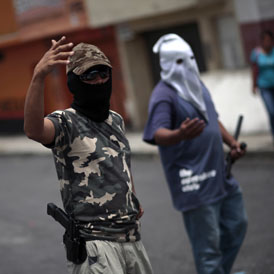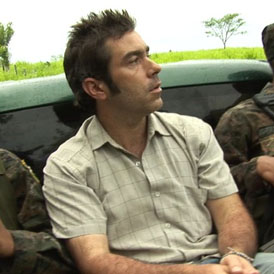On the trail of Guatemala’s drug gangs
 Lindsey Hilsum
International Editor
Lindsey Hilsum
International Editor
Exclusive: Filmmaker Greg Brosnan, working for Channel 4 News, gains access to investigators hunting a Guatemalan drug gang – as International Editor Lindsey Hilsum reports.
Warning: You may find some of the details in this report distressing.
Twenty-seven men, women and children – poor, innocent migrant workers, hacked to death on an isolated farm.
As a former correspondent in Guatemala, I’d listened to countless first-hand accounts of army massacres during the 1960-96 civil war. But this was 2011. The cold war was over and this had nothing to do with ideology, it was about getting drugs to the United States.
Mexico‘s military assault on the cartels has pushed the drug-war front line south to the small and desperately poor nations of Central America. Still scarred by its long civil war, Guatemala now faces an enemy deadlier and far better-armed than the ragtag leftwing rebels ever were, and it is struggling to cope.
Drug trafficking is nothing new here. For years, local bosses have moved packages north with little interference. But the May massacre made it clear the game had changed.

The killers left a note on a wall to the ranch owner, a suspected rival trafficker, written in the victims’ blood. It was signed with the letter Z – the mark of Mexico’s Zetas cartel.
The Zetas were elite Mexican soldiers who deserted to work as muscle for the powerful Gulf Cartel. With their cruelty and beheadings, they soon turned on their former bosses and became players in their own right.
The army is Guatemala’s first line of defence. Feared during the cold war, it was a formidable force. But it had its numbers and resources slashed under 1996 peace accords and can barely afford gasoline, let alone guard Guatemala’s jungle borders.
The country has been accused of corruption by drug money, and even labelled a “failed state” but more than 100 alleged Zetas have been arrested, and that has taken guts.
“Tomas” – not his real name – has one of the riskiest jobs in Latin America. He’s an investigator for the public prosecutor’s office and I followed him into Zetas territory as he hunted perpetrators of the May massacre. A colleague of his had already been kidnapped and killed for angering the Zetas, his body dumped in pieces.
US consumers keep the cartels in business. Now the US may finally be taking notice of the chaos unravelling in its poor back yard. US Secretary of State Hillary Clinton has promised Central American presidents more aid to fight the cartels.

When I visited the site of the drug massacre, the challenge was clear. With no resources to guard it, this key crime scene was abandoned. Hats, sandals and a camouflaged rifle case lay scattered.
An army officer stared out over a wire fence, choked up. He later told me he had been one of the first on the scene. The severed heads had been lying there, tossed over the fence. He had felt enraged and helpless.
About 200,000 people died in the mass killings of Guatemala’s civil war. Fifteen years after it ended, I stood by a graveside with a family that had lost five members in this more recent massacre.
“We just want peace here, no more violence. Can’t we just all get on like brothers?” wept a mourning mother.
But unless help comes for Guatemala, another war, this time over drugs, may just be beginning.
You can see more of documentary-maker Greg Brosnan’s work at Streetdog Media.
-
Latest news
-
Fans react to football clubs increasing season ticket prices4m

-
‘We’re still a long way from justice’, says infected blood scandal victim5m

-
Infected blood scandal: Victims set to receive billions of government compensation7m

-
Iran’s president and foreign minister missing after helicopter crash3m

-
Yungblud launches his own affordable music festival5m

-




